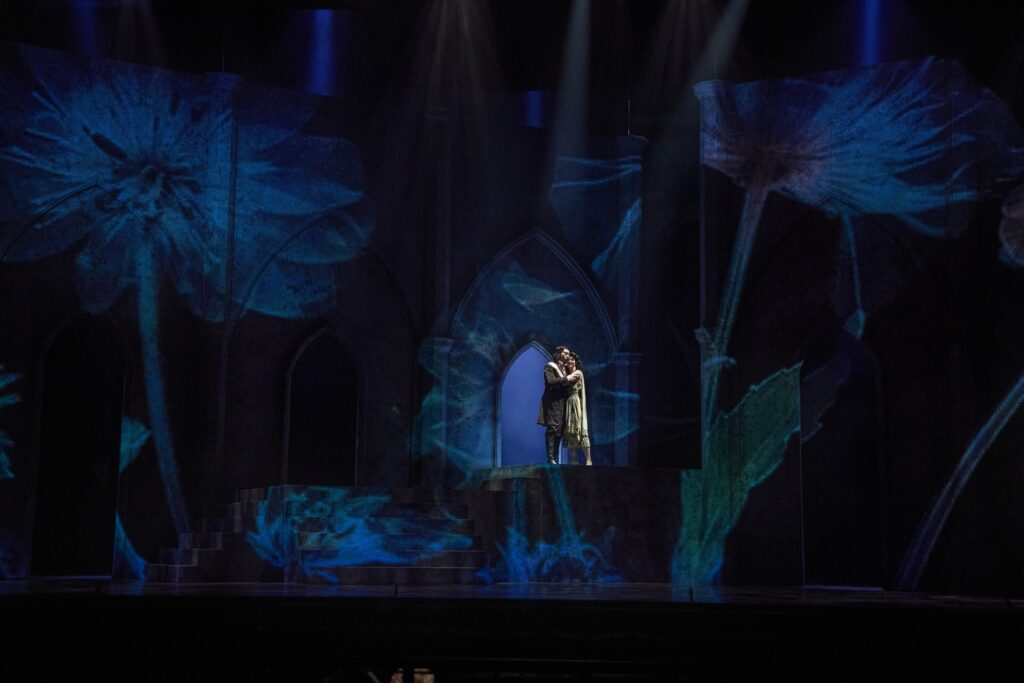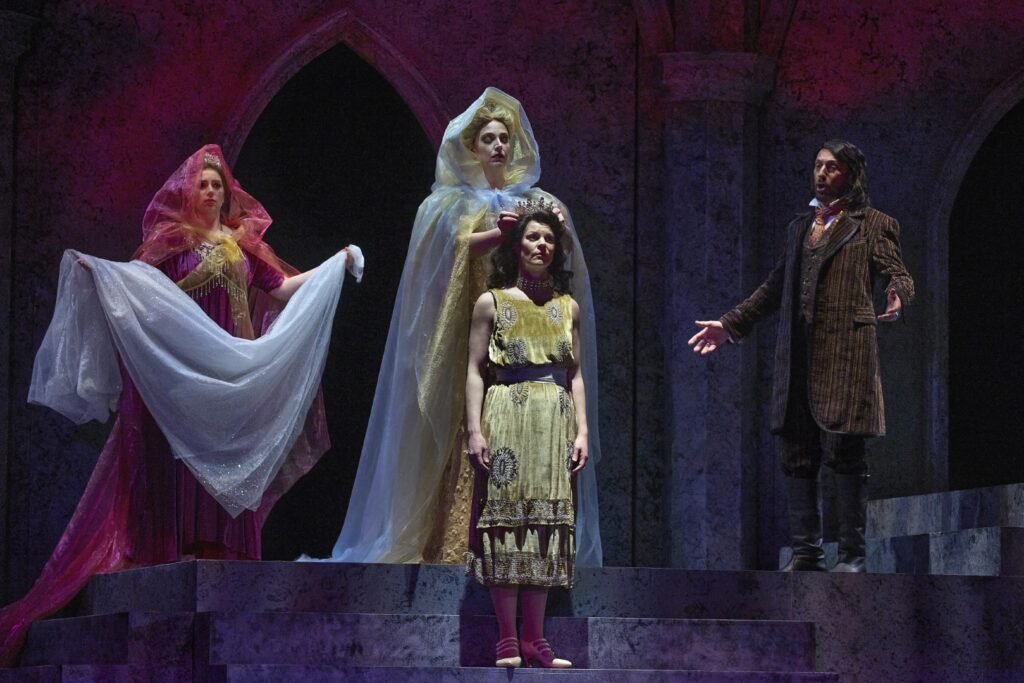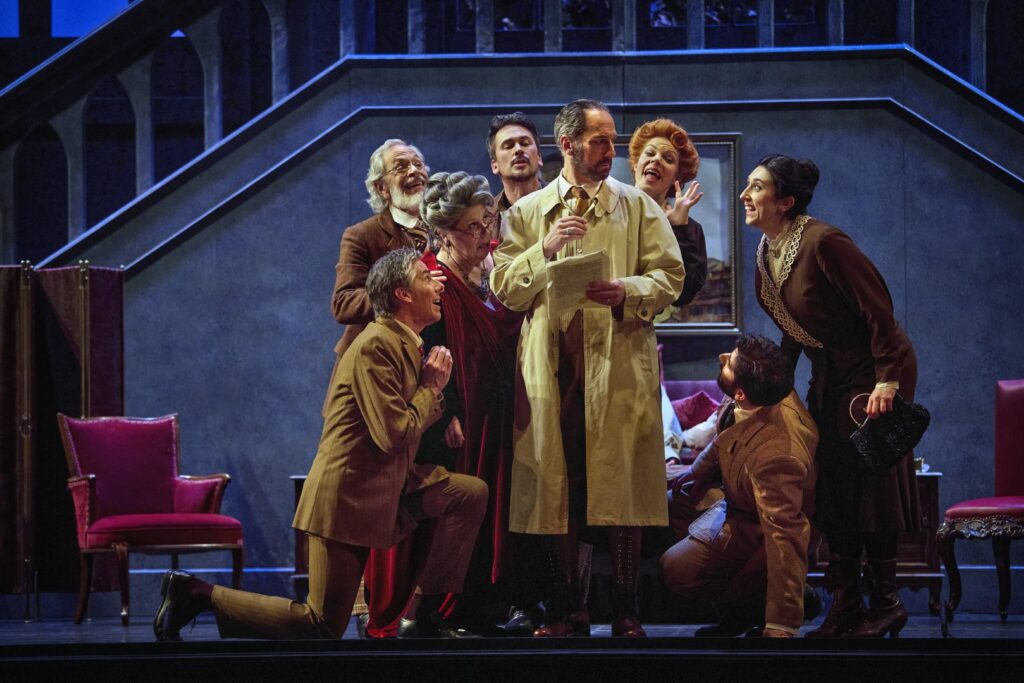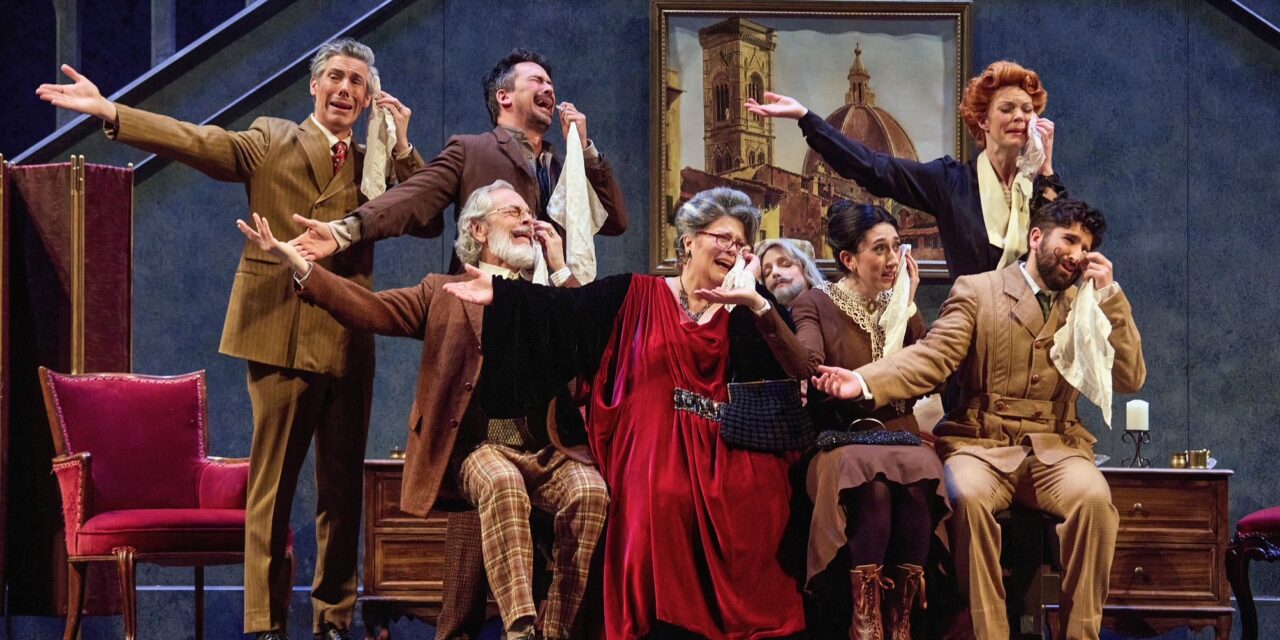Review by Mark Morris
photos: Calgary Opera
Bartók: Bluebeard’s Castle
Bluebeard : Giuseppe Altomare
Judith : Sara Gartland
Puccini: Gianni Schicchi
Gianni Schicchi : Giuseppe Altomare
Nella : Sara Gartland
Lauretta : Kirsten LeBlanc
Rinuccio : Christopher Oglesby
Zita : Marianne Cornetti
Simone : Alain Coulombe
Gherardo : Arieh Max Sacke
La Ciesca : Alessia Vitali
Betto : Tyler Fitzgerald
Marco : Phillip Addis
Maestro Spinellocio & Pinellino : Nicholas Murphy
Gherardino : Cantare
Ser Amantio Di Nicolao : Colin Mackey
Guccio : Luke Noftall
Stage Director : Alain Gauthier
Set & Lighting Design: Scott Reid
Costumes: Heather Moore
Calgary Philharmonic Orchestra
Conductor : Jonathan Brandani
Southern Alberta Jubilee Auditorium
April 9, 2025
Calgary Opera closed their 2024-2025 season with an unexpected double bill, combining Béla Bartók’s symbolist Bluebeard’s Castle with Puccini’s comic masterpiece, Gianni Schicchi, at the Southern Alberta Jubilee Auditorium.
The ostensible link was that both operas were first performed in 1918 – an idea that might have had artistic mileage, but wasn’t followed through. No suggestion, for example, of reactions to the World War I, and anyway Bartók’s opera had been composed in 1911. It was, though, a perfectly valid juxtaposition in its own right, pitting a dark quasi-tragic drama against an out-and-out comedy – the classical Greeks would have approved the pairing, and indeed Gianni Schicchi was written as part of a trilogy designed with just such contrasts (the other two are the verismo Il tabarro and the spiritually religious Suor Angelica – I have once seen a production of all three on one night, and the contrasts are very effective, even if they do make for a long evening). I suppose another connection between the two works is that Bluebeard starts with a reference to the audience clapping, and Gianni ends with the same thing.
As far as I can ascertain, Bluebeard’s Castle had been presented in Alberta in its original form only once before, in Edmonton Opera’s 2005 unforgettable staging of Robert LePage’s harrowing and spellbinding production with Jason Howard and Suan Marie Pierson (Edmonton Opera’s production this year completely changed the subject and tone of the opera). This new Calgary Opera production was not in the same league, but perfectly satisfactory in introducing new audiences to the opera.
Béla Balázs’s brilliant but enigmatic libretto, beautifully structured and nuanced, retells the traditional fairy-tale. As told by Perrault in France in 1697, Bluebeard’s new wife is left alone while he journeys. He leaves the keys with her, and, against his instructions, she opens seven locked doors, the final one revealing six dead former wives. She is saved from becoming the seventh by the timely arrival of her three brothers, who rescue her. In Balázs’ version, Bluebeard brings back his new bride Judith to his gloomy castle. In the castle are seven doors, and Judith demands to open them. The first five reveal aspects of Bluebeard’s estate: the torture chamber, his armoury, his treasury, a secret garden, a vista of his vast and beautiful lands. The sixth door reveals a lake of tears, the seventh Bluebeard’s three previous and presumable murdered wives. One by one they bring jewellery to Bluebeard, before returning one by one through the seventh door. Bluebeard dresses Judith in the jewellery, and she joins the other wives in through the seventh door.
It is widely accepted that the symbolism of this opera represents the internal life and emotions of Bluebeard himself – the Hungarian conductor István Kertész, one of the finest interpreters of the opera, suggested that Bluebeard was Bartók himself, and that does not feel too far-fetched. Freud’s ideas were already widely known. Even more apposite are the ideas of Carl Jung on symbols and psychology, and, although Jung’s Psychology of the Unconscious was not published until 1912, Béla Balázs may well have know of him and his ideas.
Certainly a Jungian interpretation makes sense of the librettist’s symbolism: the castle represents Bluebeard himself (and the fact that it is a castle indicates his desire to keep the rest of the world at bay), Judith his feminine aspect (the anima). His failure to integrate that side of his personality (repeated failures, the opera suggests) leads to the internal conflict and suffering represented by the blood that seeps out of the first five doors. With the final failure – and we know it is the final one, as the three wives represent morning, midday, twilight, and Judith night – he is left unfulfilled, and, on the surface as well as symbolic level, alone.

Nor does a Jungian view of the opera preclude more 21st-century approaches to Judith’s agency. One interpretive decision that has to be made is whether Judith is largely victim, reacting to her husband, or whether she is actively trying to change him. In Calgary, director Alain Gauthier had clearly decided on the latter, and the interaction between a slightly stiff and emotionless Bluebeard, played by Giuseppe Altomare, and Sara Gartland’s Judith was effective and convincing, and generally well sung, although bass-baritone Altomare’s lowest bass notes were rather lost. The Calgary Philharmonic, with conductor Jonathan Brandani, played what is one of opera’s finest scores well, if sometimes missing some of the bite, especially in the earlier part of the opera.
It was the staging, while being perfectly serviceable, that disappointed.The spoken prologue, often omitted in performance, was inexplicably given in English (the work was sung in Hungarian, with surtitles), and not very well at that – it sounded dreadfully stilted and histrionic, which created quite the wrong tone. Gauthier, and his set and lighting designer Scott Reid, only half-embraced the symbolism, exemplified by the wives putting the jewellery on Judith, not Bluebeard, as specified in the libretto, and by all three remaining on stage to lead Judith back through the seventh door. Quite what the resulting changed symbolism meant was unclear. Reid’s set was excessively plain without any menace of dark, looking more like a Moorish mosque than a castle, and the projections onto the walls as each door was opened did not work. The vista of the estate in the fifth door looked as if the castle had been decorated with a child’s room design of stars and galaxies across walls and ceiling. Waves flowed across the walls for the sixth door (the lake), while Judith specifically sings “I see a quiet, grey lake. Motionless…How silent, how still.” The doors, too, and especially the lighting that flows from them, were more boring than they could have been. Symbolism is a tricky thing to handle, especially in symbolic opera, where the visual symbolism has to enhance the musical and sung symbolism for the full impact to be achieved, and here it didn’t quite do that.

No such qualms about the production of Gianni Schicchi in the second half, with Gauthier and Scott again responsible for the production. Heather Moore’s costumes were decidedly Italian 1918, which worked very well – Gianni is one of those rare operas that can be set in virtually any period without any incongruity, such is the universality of Giovacchino Forzano’s libretto. That libretto is surely the most brilliant of any comic opera, especially as it is based on the slimmest of mentions in Dante’s Inferno (and is thus actually based on a real character). The pace never flags, only being varied by the famous aria ‘O mio babbino caro’. The family trying to get the will of a dead relative changed are vividly characterized, almost verging on caricature, as suits comedy, but never over-stepping. The twist at the end works perfectly. And all this is matched by Puccini’s irrepressible score, well paced here by Brandani, and well played by the Calgary Philharmonic, who brought out the brilliance of the scoring.

Gianni is very much an ensemble opera, and Gauthier created a wonderfully frenetic family, very well coordinated in more formal dance-like moments, and happily eccentric individual characters in the general melee. Scott’s set neatly incorporated the Moorish arch theme from Bluebeard, while providing ample stage elements for the various shenanigans – it was ironic that the two doors here opened onto genuine rooms behind, where Bluebeard’s had been blank.
There was lots of tension when needed, and this was a very entertaining – indeed, a very funny – production. The singing too, was of a unified standard. Altomare was a sly Gianni, rather than a Falstaffian one, and Marianne Cornetti and Ariah Max Sacke were particularly effective in their character vocal-acting as Zita and Gherardo respectively. Kirsten Lablanc, though, did seem a little miscast as Lauretta – the role stands apart from the rest of the characters, and ideally needs a lighter, more lyric soprano to get that contrast.
The rather sparse audience on April 9 (had Calgary Opera regulars been put off by the idea of a Bartók opera?) loved it. And those who missed it, missed what was overall not only a satisfying evening, but, in the Puccini, a real treat.


